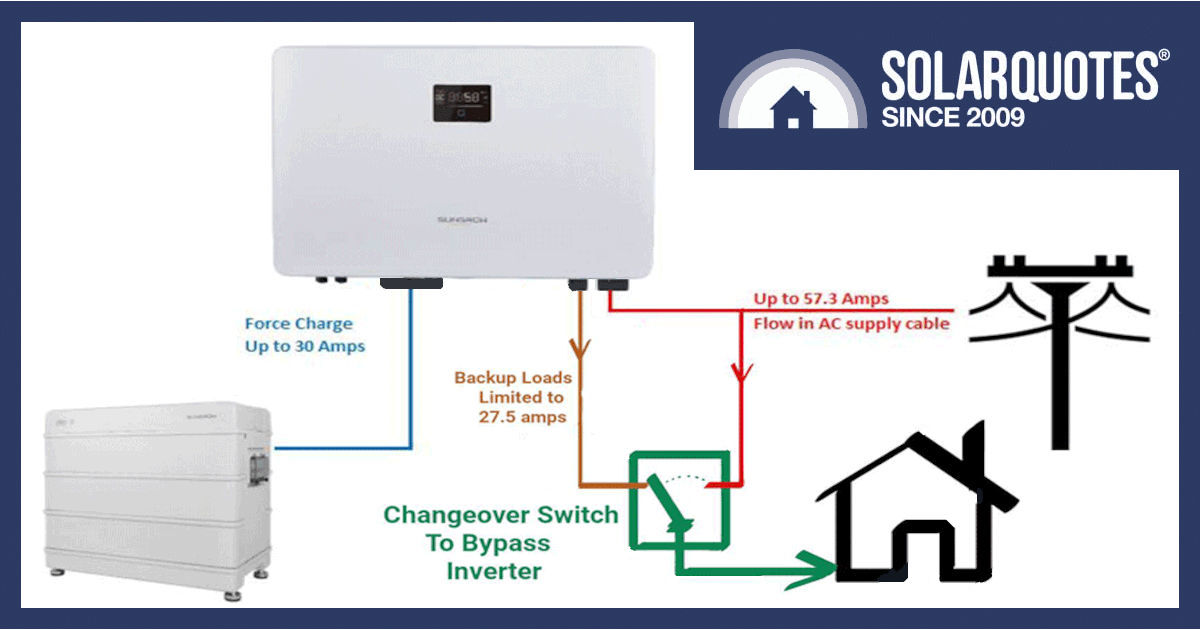
The green parts are thanks to SolarQuotes. In normal operation, grid energy goes in the hybrid inverter through the red line, out along the brown line, and into the home’s essential circuits via the green line. If the inverter fails, it can simply be bypassed with the green switch.
Home batteries used to be a niche market for tech enthusiasts and those needing emergency power. But as battery-backed hybrid solar systems proliferate, the solar industry is learning that even the best plans can go awry.
SolarQuotes now recommends to our installer network that if they sell a home battery with backup functionality through a hybrid inverter, it must have a bypass switch.
Most hybrid solar power systems have limited capacity, so you invariably choose only the most important home circuits for backup. If the hybrid inverter fails, it can prevent grid electricity getting to those essential circuits. They’ll lose power. And you don’t want to be calling an electrician to come and rewire the switchboard at the drop of a hat.
If your essential circuits stop working, the lights go out and the fridge goes warm, you need a simple switch to restore ordinary grid power until the system can be diagnosed a repaired.
The grid is legislated to be 99.998% reliable, (you’re entitled to get upset if you lose power for more than 10.5 seconds per year?). Many Australians go years without electricity interruption, especially in newer suburbs where the infrastructure is buried, safe from storms and kamikaze car drivers.
So for many customers the idea of battery backup is much more important than the actual capability. It becomes a somewhat emotional decision to buy a security blanket economically justified as stored energy saving a few dollars every night. Things come unstuck if that costly insurance policy fails to kick in, or even worse, ends up costing even more money and causing further inconvenience or losses.
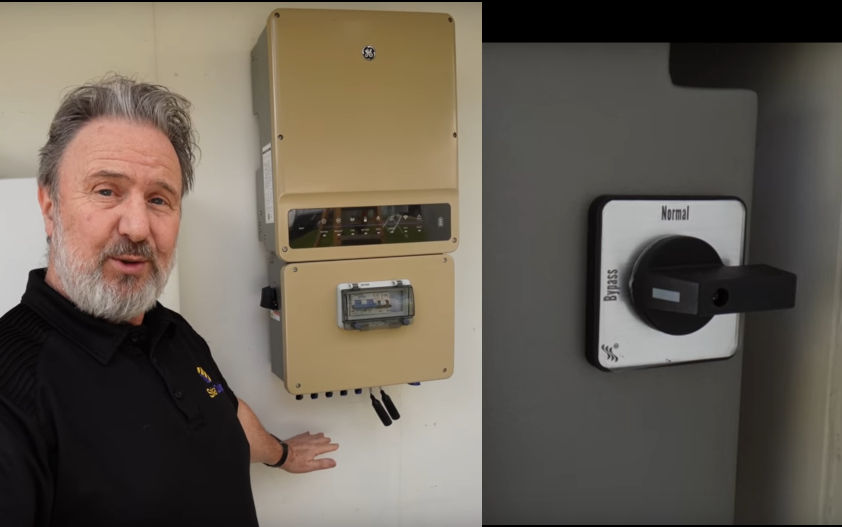
Glen Morris showing us the GE hybrid with factory-fitted bypass switch
What Are The Risks?
I’ve seen someone inadvertently unplug a deep freezer full of fish. A fortnight later, that wasn’t pretty.
From a solar installer’s perspective, if there’s no bypass switch and something goes wrong in the inverter, the reputational damage to your business can be dreadful, as you’re the crowd who sold this lemon that doesn’t work. It creates emergency call-out work that wrecks operational calendars and overtime budgets.
From a customer perspective, you’re entitled to expect a reliable product. If you have to call and demand out-of-hours service to restore power to your most important electrical essentials, it can ruin the relationship you have with the people who are there to provide warranty and technical support.
How Much Does A Bypass Switch Cost?
Included on install day, a bypass switch for a single-phase house might be an extra $100. Even on a three-phase install, the hardware and labour won’t exceed an electrician’s basic call-out fee. It’s one of those things that hopefully you’ll never need, but when you do, it pays for itself immediately.
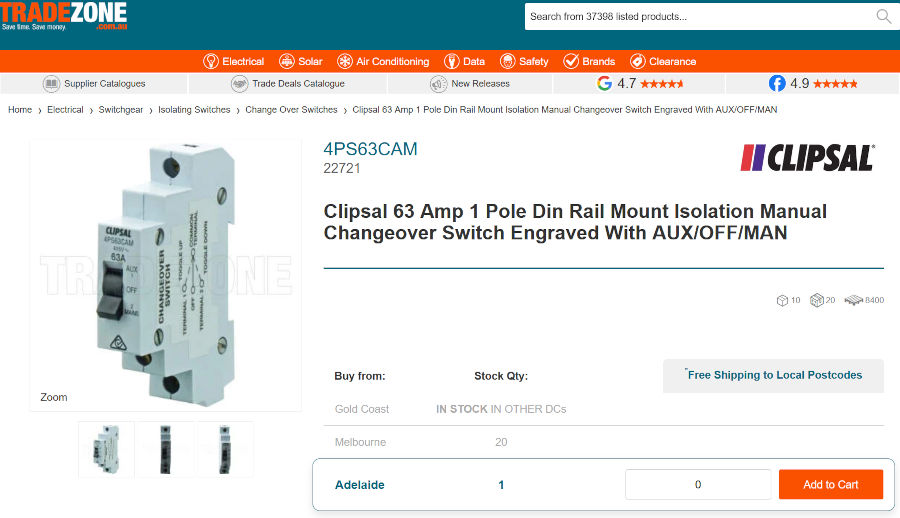
In jurisdictions where off-peak tariffs are available, these changeover switches were often engraved “Day – Off – Night” because they were used to boost hot water tanks.
If You’re Struggling For Switchboard Space
If your switchboard is jam-packed, especially a 3-phase one, you may need a complete overhaul or an additional load centre added inside or next to your main switchboard – especially if you’re backing up more than a couple of circuits. As we’ve written previously, adding solar panels can be an excellent time to upgrade your switchboard and add hot water control, because it’s often a good deal more expensive to do after the fact.
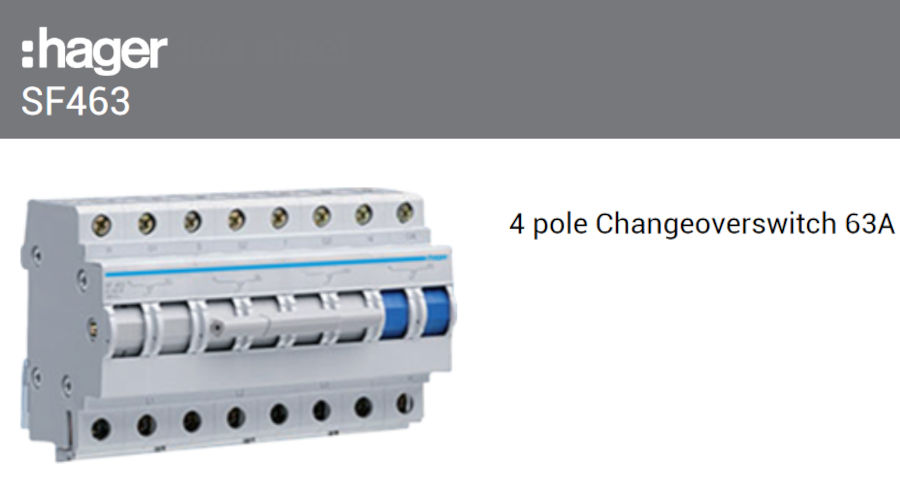
3 Phase changeover switches can be huge.
Labels, Labels, Labels.
Meeting the letter of the law means you should have a completely separate switchboard for loads running off an alternate supply. Pragmatically, this often doesn’t happen. Most places simply have a few labels in the meter box.
In any case, you should have comprehensive and easy-to-read labels so any householder, plumber or ordinary domestic electrician (we call them roof possums) can understand that a home battery is present, and how to isolate and bypass it.
When workplace safety laws dictate anyone entering the roof space must first turn the power off, those working on the house must be aware the hot water may turn on automatically or that switching the grid supply off doesn’t mean the whole house is dead.
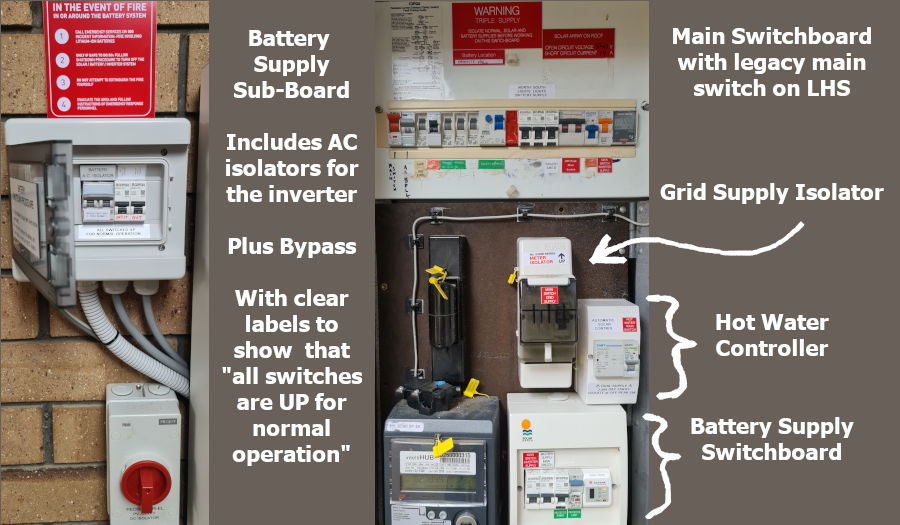
There’s a lot going on here, which means labelling what you have to, so it makes sense. image credit Solar Depot
Of Course, There Are Exceptions
Fanbois unite! If you have a Fronius Gen24, or some other parallel connected hybrid inverter (like SolarEdge), then there’s no need for a bypass switch.
Systems using a contactor or a “backup box” don’t have the essential circuits passing through the inverter, so if anything goes awry with the hybrid, the backup supply isn’t affected.
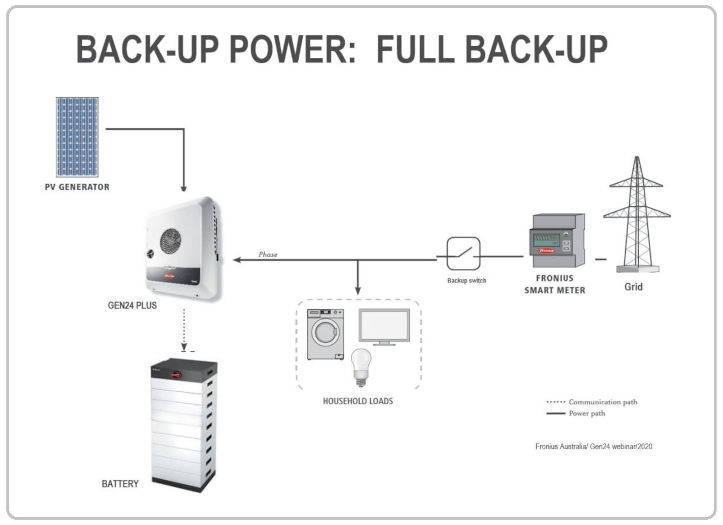
If you erase the three items on the left of this image, your household loads are unaffected.
Fat Supply Cables Are Also Essential
Many experienced solar electricians have been caught out by the fact that hybrid inverters can impose really big loads on the grid connection. After a decade of connecting 5kW solar inverters on 6mm² cable with a 32amp breaker, they haven’t realised that when you have backup loads running and force charge a battery at the same time, there could be a sustained 55amps or more drawn over the inverter circuit.
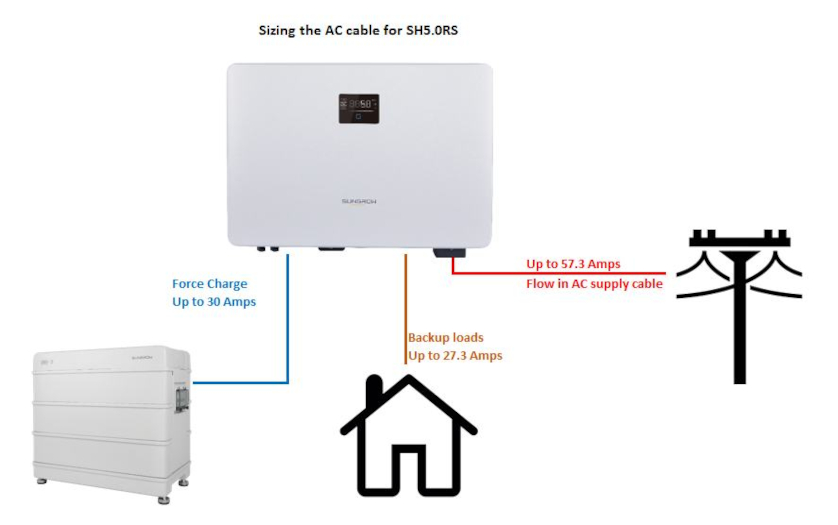
Sungrow saw the need to release this image, especially to remind installers about the demands of hybrid models.
So, when your average house supply will deliver 63amp (~14kW) via a 16mm² cable, you need exactly the same supply to the nominally rated 5kW hybrid inverter. In fact, if the hybrid goes in your garage 35 metres away, you’ll need an even bigger cable to fight voltage drop.
Insist On Reliability
For series-connected hybrid inverters, the essential circuits are powered through the inverter. If it falls over or needs servicing, you need a bypass switch to keep everything online. For less than $100, both the solar installer and the customer will sleep easier. It’s a bargain.

 RSS - Posts
RSS - Posts



A related question, how difficult is it to add additional devices/circuits to your nominated backup circuit at time of installation? I ask because at the time of our install (which included a Powerwall 2), the installer excluded all AC units, which seemed sensible. But now after a year we see that we’d have ample solar to ruin at least 2 or 3 of those should there be a blackout. Blackouts are incredibly rare for us, so it’s not an urgent thing, just curious how involved re-wiring things in that way would be.
Also is it correct to say that if there is a blackout in the middle of the day, your solar will only power devices on that backup circuit, even if the battery is already fully charged?
Hi Nick,
It’s not hard to add circuits, probably 5 minutes work to swap a wire, 25 more to screw all the covers back on, make a label and fill out a certificate. We covered the opposite scenario here but the process is the same :
https://www.solarquotes.com.au/blog/electricity-consumption-mystery-solved/
Be aware that AC can use a lot of energy though and some units have large inrush currents, so you need a pretty gutsy surge rating to meet that.
Thanks! I noted Finn saying somewhere here a while back that AC is part of his backup circuit which made me ponder that as an option. All of my AC units are either 2.5 kW or 3.5 kW, so not large (not sure if that reduces any possible inrush). Exporting up to 40kWh per day at the moment, while using the AC units, so not too worried about usage except maybe on the darkest winter days. The system is designed for eventual EV charging too, thus the high capacity.
If the A/Cs are good quality inverter A/Cs the in rush current is absolutely minimal. They start with a trickle and work up to full speed.
I have nothing higher than 2.5kW units around the house, (mostly Panasonic) and they each use around 500w if running flat out on cooling, probably 20% more on heating, but MUCH less when starting.
I also have one of these in my RV, which works fine on just a 1kW inverter from 12v.
Great feedback, thank you.
Hi Nick,
Adding circuits to the backup should be straightforward unless your inverter is connected to a sub board and the back up fed from out there. Be aware that some AC units have large inrush currents when they start (ie 6 times running current) so they max tax the inverter heavily. Try it and see is the only way to know.
Battery and solar will only ever power things on the backup circuit when there is an outage, be aware that if the battery is fully charged when the power goes off it may take some seconds to swap over, whereas if the battery isn’t topfull the changeover is often seamless.
We have the bypass switch mentioned. Our landlord accused us that our solar system is giving a feedback and trips the main power leading to all the houses we installed a 5kva hybrid backup system
Hi Gaynor,
Without any other detail it’s hard to say but your hybrid system should only ever put less load on the mains supply. The only way I could see you increasing the amount of energy coming onto the premises would be if you were charging the battery from the grid, but 5kW is still only around 22amps, so it would just expose an existing shortcoming perhaps?
Grid reliability standards do not include outages for transmission issues such as powerlines brought down by trees, errant drivers or for normal scheduled maintenance. The vast majority of outages are transmission issues and not the grid.
Hi Alex,
You make a fair point but to avoid confusion I think the standard terminology is a little different. Roughly speaking transmission is the interconnectors, big lattice towers, run by companies like ElectraNet, using hundreds of thousands of volts.
The less reliable parts are the medium and low voltage distribution networks, the poles and wires stemming from local substations running 11kV & 400v in your street
Another excellent, and timely for me, heads up about potential issues that can be headed off at th4 install “pass”.
As you didn’t mention it, I take that Sungrow hybrids are NOT parallel to grid supply and so an accompanying inverter bypass switch should be considered. Csn you co firm please?
Thr latest or soon to be released Sungrow 9.999kw Hybrid effectively doubles the previous backup circuit capacity so would be planning nkt designating any essential emergency circuits but backing up the the entire house. Obv an inverter failure and thus no power to anything would be a major issue.
Cheers.
Yes Neil,
Sungrow are a series hybrid and they include this bypass switch advice in the instructions. The good news is that with the new SH10RS, it already comes with a manual change over switch (63A)
Hi see there is a change over switch for single phase units can i get one for a 5kva sma sunnytrip power with a 10kw back up battery. I was told at all stages of installations it was not possible but I am sure it is?? And your comments seem to confirm that please reply Bob
Hi Robert,
Might depend on your battery, what type is it? The Sunny Tripower is a 3ph grid connect inverter I believe.
https://www.solarquotes.com.au/blog/kw-and-kwh-what-is-the-difference/
Hi Anthony yes I have a 10kw li ion senec battery can i can i get a change over switch for part or all please bob😄
Yes I don’t think you’d have a problem with that, most electricians would be able to handle it, just needs an appropriately rated switch.
Please clarify for a dumbo like me if I get the change over switch installed can i still get charge to my battery while using the switch Bob 😄but to me i don’t think you gave a clear answer??
Hi Rob,
It could vary slightly depending on how your electrician decides to wire it up, but yes, you could have the “essential” circuits switched back onto straight grid power while also having the hybrid solar inverter working. Bear in mind the battery can be charged from solar on your roof or grid energy, so the question about being able to charge actually has a couple of different answers.
With a hybrid system there is a grid supply into the inverter which carries mains power IN or OUT depending on whether there’s sunshine to be exported or whether you’ve activated a “storm switch” to pre-emptively charge the battery from the grid in case of an outage.
There is also an “essential” circuit OUT of the inverter. This can be supplied either by the mains energy passing straight through the inverter or by the battery, whether the grid is available or not.
If the inverter fails, the bypass switch is there to hook your essential loads back up to the mains.
However if you have the hybrid system turned on still, it will continue to charge the battery.
Hi again Anthony are you saying the 5kva sunnytrip 3phaze sma inverter can do what we discussed? If so can you give me some names and numbers of electrisions in mandurah wa or perth that I could contact ,as I have asked my normal elecy and he is scared of making a mistake so so would like to find someone who does this regularly please .Bob I am asking for electrions in my area please
About 8 or i9 years ago we had a 5 day blackout in the Sunshine coast hinterland due to H/V storm damage. The township of Maleny and surrounding areas has no phone (mobile and landline) no eftpos so had to rely on cash which entailed travelling 10 km to obtain.
I am off grid with grid backup so my nehbours used my spare fridge.
The point I’m concerned about is major blackouts due to terrorism etc. Without internet nothing works now and it all relies on the grid. Sorry if it’s a bit off subject but I’m all for home batteries.
Hi Anthony,
Another brilliant and insightful article, for which most batteries owners will be unaware. Thank you also for the effort that you have put into to researching the various aspects. I particularly appreciated the section regarding which inverters already contain Bypass Switches. Could the Solar Battery Comparison Table (https://www.solarquotes.com.au/battery-storage/comparison-table/) be updated with and additional row of information about whether the system contains a Bypass Switch, please?
Thank you again for helping home owners make informed decisions.
Best wishes
Andrew Mac
To prevent this, we only install back up on a designated power point (double gpo).
This way the customer can choose what to run on the back up via an extension cord. Hybrid inverters have limitations, especially in back up.
Designated circuits on back up cause major headaches.
One of the first hybrid installations with backup I was involved with 10 years ago taught me this early on. A customer was the first in their street to have a hybrid and battery storage. It wasn’t long before a major storm rolled through and power was lost in the area. The customer was ecstatic that they still had lights and power. That was until in the major storm that was rolling though, a lightning strike fried the inverter. When power was restored, the customer had power to all of their circuits EXCEPT the essential loads that were supplied by the now failed inverter. This meant a late night emergency call out for an electrician to rewire loads, costing way more than what a single phase bypass switch would have costed.
Hi Anthony,
Regarding backup circuit sub-panels, there is a bit of a buzz in the USA regarding smart panels that can more dynamically adjust the load on the battery backup, based on essential, desirable, etc, all in the primary panel. They monitor the load and battery, and will remove (or add) circuits in depending on the current state of power reserve. It looks like a more flexible way to manage a grid/solar/battery dynamic load and supply.
There seems to be some manufacturers in Australia with smart’ish breakers, but it would be interesting to hear the state of play from the Solar Quotes Team.
Cheers,
Brian
Hi Brian,
It’s certainly an interesting development but I’ve not seen it here as yet. The 110v peasants do have the luxury of a little more space in their quaint old metal switchboards(?) but I think the way you’d do it here would be using smart switches/gpos controlled by home assistant software. That would be the easiest way to get multiple loads switched.
If you’re just talking about a single circuit, like hot water or a pool pump, then a simpler “sunshine circuit” could be added, (Fronius do this really well) controlled by your solar inverter or catchpower relay.
Hi,
I had my board wired with 3 change-over switches. I can select which group of circuits run from mains, if needed. I also have an automatic bypass around the inverter/battery system in case that fails. As the Irishman said: “To be sure, to be sure”.
b0b
Yes, we need bypass switches. These are common sense for anyone who is installing residential systems.
Do you know what’s also common sense… not installing a Chinese Inverter, they’re like installing a backdoor into your home just for hackers.
Anthony Bennett writes….
“Fanbois unite! If you have a Fronius Gen24, or some other parallel connected hybrid inverter (like SolarEdge), then there’s no need for a bypass switch.
Systems using a contactor or a “backup box” don’t have the essential circuits passing through the inverter, so if anything goes awry with the hybrid, the backup supply isn’t affected.”
So…what happens when a component within the Fronius/Huawei/Solar
Edge/Growatt backup box fails?
Same problem as having the backup running through the inverter is what.
You need a changeover switch for ALL inverters providing backup built-in or separate box, it matters not.
I seek clarification of something.
The hybrid inverter is a Goodwe GW5000-EH single phase hybrid inverter incorporating supposed UPS. The protected circuit includes the whole of the house circuitry, apart from the bore pump and the solar HWS booster element
1. According to the current datasheet (https://www.goodwe.com.au/Ftp/Downloads/Datasheet/AU/GW_EH_Datasheet-AU.pdf with timestamp of last modification, “Wed 01 Feb 2023 19:29:33”), the inverter can draw from the electricity grid, up to 10kW at 230V (10000/230=43.47A) (“Max. AC Current From Utility Grid (A) 43.4”), and
2. According to the datasheet for the model, with the timestamp of last modification, of “Wed 22 Dec 2021 11:26:53”, is
“Maximum Output Fault Current 65A, 5μs”
Now, the A/C bypass switch that was installed with the system, in 2022 (so, the latter inverter datasheet is applicable) had a current load rating of 25A; that bypass switch has just been replaced with a 40A switch. Upon asking the electrician about this, the electrician told me that the applicable cabling is also rated at 40A.
So, my question for which I seek clarification, is this; given the specifications of the inverter, what should be the current load ratings, for the cabling both between the mains switch and the bypass switch, and, between the bypass switch and the inverter, and, what should be the current load rating of the bypass switch?
To me, it seems logical that the answer to each of those three questions, should be 63A; the same as the mains switch.
I am wondering, whilst, to me, my query is applicable to all single phase grid connections, rather than being dependent on rules appliable to a particular grid, because this applies to the SWIS grid, instead of the NEM grid, whether this query should be directed to Western Power.
Also, as he is (I believe) a certified electrical engineer, I am wondering whether Finn Peacock is the appropriate authoritative person to answer this.
Please advise.
Thank you in anticipation.
Hi Bret,
Yes you likely need a 63a circuit as we’ve noted here :
https://www.solarquotes.com.au/blog/installers-view-sungrow/
Cheers